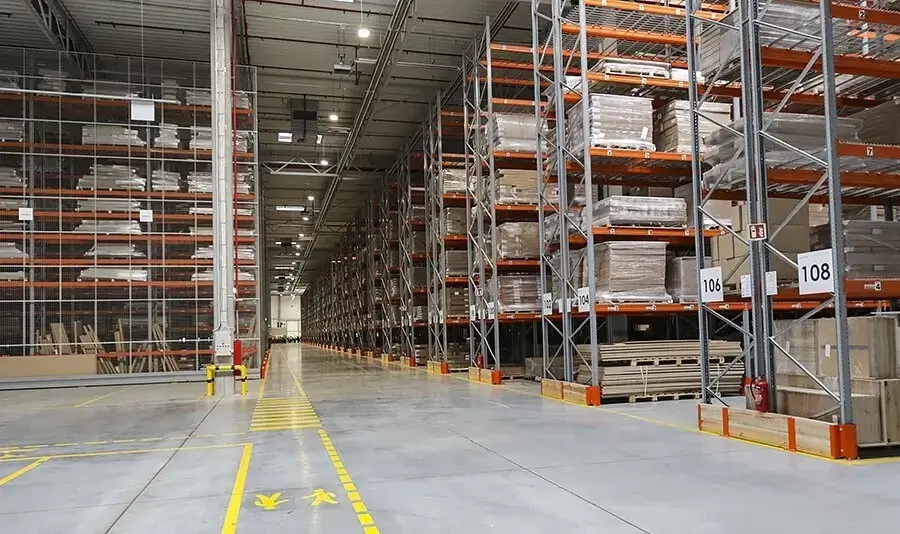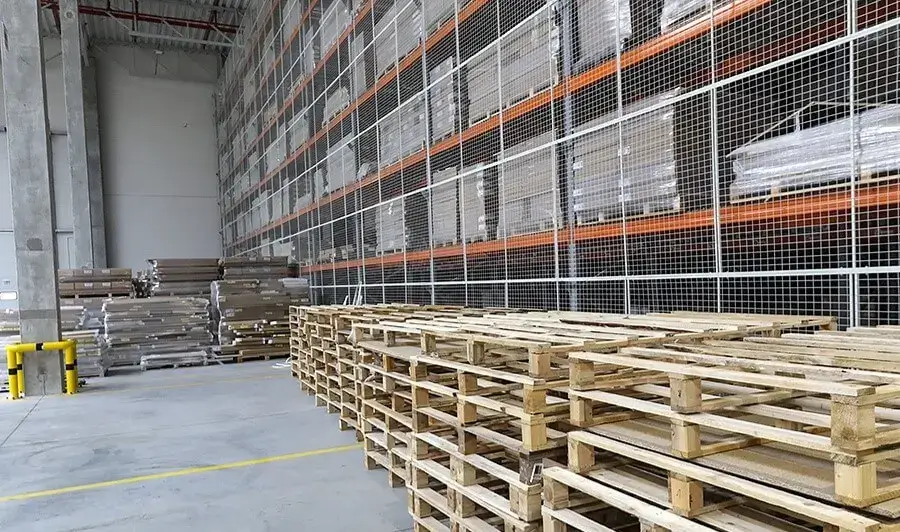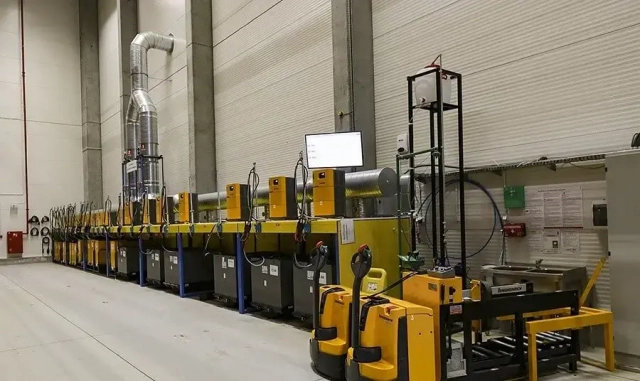In what warehouse equipment should you invest in order to achieve effective Logistics?
In the previous article, together with Andrzej Lada-Kubala, who is the Operational Director of Wójcik Furniture, we talked about how to create a warehouse project. The article deals with the issue of the building itself, its location, and the strategic perspective on the security of the team and operations.
Below you will find the continued history of the analyzed investment. This time we are going to discuss warehouse equipment and its layout. Factors influencing the choice of racks, trolleys, and the arrangement of zones.
Of course, in each industry, and in fact in each distribution channel, the choice of specific equipment will be different. However, the way of thinking presented by Andrzej can be a model worth following.
Warehouse equipment is not just about racks
We already know what we want to build. It’s time to deal with the equipment. Nothing easier. There are several large companies that sell high-bay racks.
It is enough to make three, maybe four calls, and in two weeks the finished solution will land on the desk. Unfortunately, there are few “lucky” ones who have EUR pallets exclusively and with goods that do not protrude beyond the outline, issued in full pallets only.
The furniture industry is not one of them. In our case, the carriers are twelve different dimensions. Not all of them are made in the standard of a single-use pallet weighing up to 1300 kg. Our largest pallet is 2200×1200 mm with an overhang of up to 2400 mm and a weight of 1270 kg, stored longitudinally.
Then comes a question. How to put such a “thing” on the beams of a frame rack?
Before talking about simple issues such as filling racks, let me give you a few words about the concept. In addition to its storage function, the Distribution Center also serves as a place for picking shipments.
This fact has a critical impact on the design of space layout. The process of picking at the piece level requires a slightly different approach to the layout of the warehouse.
Our early concepts assumed use of racks in a narrow aisle system operated by a system trolley with the delivery of pallet units from the reception area by AGV cooperative trolleys.
Source: Wójcik Furniture. Press materials.
In order to achieve the best fill rate per m2, in the concepts we adopted the model of picking from the floor level in racks, that is in a narrow aisle. To be able to implement such a non-standard process, we widened the channel of the VNA system trolley from a minimum of 1.75 m to 2.2 m so that a horizontal forklift truck with operators collecting single packages could work in the aisle.
For the sake of work comfort and safety, we designed an additional traffic light system for channel occupancy and equipped the system trolleys with safety heads that analyzed the zone in which they moved.
Thanks to this solution, we were able to give up the so-called two-stage picking and an additional picking area. According to careful estimates, we saved at least 4000 m2.
Warehouse design is the art of choice. Location defines building conditions. As a result, also the type of racks and even the transport trolleys used. However, the principle of choice also works the other way around. So it’s best to start at the end. Specify operation parameters. Then adjust the technology and equipment we need. Just as in the case described by Andrzej. From my experience, I will only add that simulation tools are very helpful in this process. I wrote about this in the article – Reorganization of the warehouse or how to increase the efficiency of logistics.
— Adam Sobolewski
Safety first!
Of course, the described concept leaves much to be desired in terms of performance. For example, the inability to turn the trolley back after picking up the goods.
This was acceptable in the context of the priorities we had chosen for our project. Operationally, the most important element was the increase in the storage capacity of the warehouse.
In the end, however, we chose a different arrangement for security reasons. Firstly, with the specific pallets included in our process, we were not able to achieve the expected lifting capacities at height in the VNA system trolleys.
Secondly, also the AGV solutions tested during the project had to fail when confronted with the size and weight of our pallets.
An important problem with AGV trolleys was the fact that a single trolley is CE certified. However, the entire system based on several AGV trolleys moving between VNA trolleys and warehouse personnel does not have such a certificate.
In case of an unwanted event, this could cause claims against the company and the system provider. However, the concept is worth knowing, because picking from the floor can be an interesting solution in other industries.
So let’s go back to filling the racks and problems related to the dimensions of the pallets. The carrier used in the processes of Wójcik Furniture is unusual, not only because of its length.

Source: Wójcik Furniture. Press materials.
Width is also an important limitation. A pallet with a width of 1200 mm, made in the standard of a single-use pallet, is not suitable for classic storage in frame racks. In the previous warehouse, we solved this problem by introducing an internal carrier.
On the one hand, it is much stronger. On the other hand, it is much more expensive and requires stacking of a single-use pallet together with the load. The solution works. However, it generates additional costs and operational difficulties associated with the restoration of stock in case of damages. It also takes away around 20 cm from the height of each slot.
With 7 storage levels, this means over 1 meter less in usable height. The solution to the problem turned out to be rack fillings and widening the frames. The frame has a standard spacing of 1100 mm. We decided to buy racks with 1200 mm wide frames.
Exactly the same as the width of our pallets used for storing furniture. This idea allowed us to store long pallets longitudinally in a pallet row.
Managing large Logistics operations always requires some compromises. Process compromises, which translate into the service offered to the client, or cost compromises, which translate into the finances of the entire organization. However, in the case of worker safety, you should never make compromises. I have had the pleasure of working in companies that use this approach. But they were global corporations. The example of Wójcik Furniture is a praiseworthy application of the safety-first concept in Central Europe.
— Adam Sobolewski
Alternative solutions worth using
One of the last challenges we had was to support the pallet between the rack beams. This is an unconditional requirement for longitudinal storage. The problem seemed simple, because who could have had chipboard at a better price than a large furniture manufacturer?
However, consultations with fire protection specialists made us realize that when deciding on one level of sprinklers under the ceiling, we cannot use a full shelf. In the event of a fire, we would limit the free flow of water to the lower levels of the racks.
There were two solutions. Either we could put sprinklers on every level. Which was out of our budget. Or we could use openwork fillings. However, the first truss valuations also took our breath away.
The trusses cost more than the racks with delivery and assembly put together. So we started a price fight. Although the contract was large, the truss price reduction was small.
So we finally used mesh shelves. Typically, this solution is used to store light bulk cartons or light pallet carriers.
Talks with the majority of Polish manufacturers of mesh fillings and two foreign ones, combined with making our pallets available for testing and nearly a month of tests resulted in the design of a shelf made of thicker wire.

Source: Wójcik Furniture. Press materials.
Ultimately, this solution allowed us to reduce the cost of fillings by nearly 60%. However, in order to guarantee the safety of the solution, we asked the selected manufacturer to carry out and document load tests.
Another example of an unconventional solution we came up with was to secure single racks standing on the edge of a communication road. If the rack in the warehouse is adjacent to a zone where people can stay, the back of the rack should be secured.
As a standard, a steel mesh is used, attached with distances to the rack frames along its entire height. This is the solution that we decided on. However, as part of the methods analysis, we came across a solution based on a woven polymer mesh.
This method is much cheaper and easier to install. It can be successfully used in warehouses where lighter packages are stored.
Warehouse equipment can cost a lot of money. In press comments or financial statements of listed companies, amounts range from a few (around a dozen) up to a hundred (several dozen) millions of EUR. An example is an LPP investment or the amounts listed every year in the Zalando Investors Factbook. With such a scale of the required funding, it is worth looking for unusual solutions and considering alternative technologies. This lack of consent to the status quo and work on the team is the strategic investment in effective Logistics that I wrote about earlier.
— Adam Sobolewski
Clever warehouse equipment choice
This example shows that it is worth looking for alternative solutions. The road to building and equipping your own warehouse can be long and bumpy. Sometimes the end result can be surprisingly good, as in the case of Wójcik Furniture, and sometimes not.
Therefore, before making the decision to modernize or build a new facility, it is worth considering various options. It is worth looking for a partner who, based on previously conducted projects in various industries, will suggest good practices.
Depending on the needs, it can be an organization that will take over equipping the warehouse from scratch. It will develop the project and in some cases will also offer leasing of the technology used.
In others cases, taking into account the required pace of business development, it is better to look for ways to outsource Logistics. I will write more about this next time.
Meanwhile, if you are interested in trends in modern Logistics and want to be up to date with news on the blog, make sure to subscribe to the newsletter. Once a month I send substantial content only.
By signing up, you will gain a perspective on what is worth knowing about modern Logistics and Supply Chain. You will also be up to date with business and Logistics information.
See you soon!







1 Comment